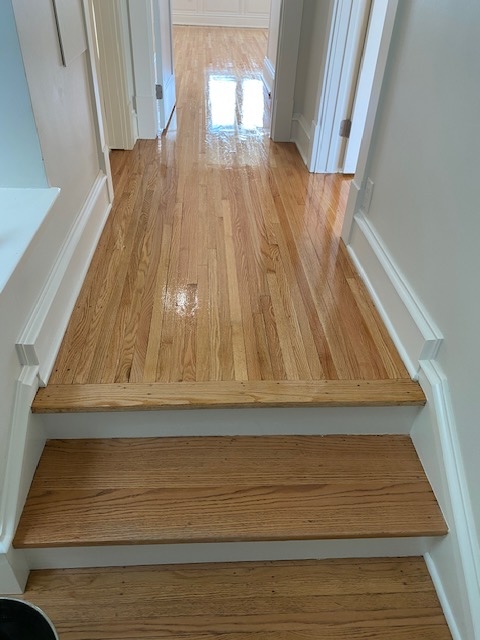How often do hardwood floors need to be refinished?

Hardwood floors are a beautiful, durable, and timeless investment that can add value and elegance to any home. Over time, however, they can begin to show signs of wear, from minor scratches and scuffs to dullness and fading. This raises a common question: How often do I need to refinish my hardwood floors? The answer depends on several factors, including the type of finish, the amount of foot traffic, and the level of maintenance your floors receive. As industry experts at Choice Hardwoods, we’re here to guide you through the process of understanding when and why you should refinish your hardwood floors, and how to keep them looking their best for years to come.
Understanding Hardwood Floor Finishing
Before we dive into the timing, it’s essential to understand what refinishing entails. Refinishing hardwood floors generally involves sanding down the surface of the wood to remove the old finish, then applying a new layer of protective finish. This process helps restore the beauty of the wood and provides additional protection against future damage. The decision to refinish can vary depending on the condition of the floors and the type of finish already applied.
Factors That Affect the Need for Refinishing
1. Foot Traffic
The amount of foot traffic your hardwood floors endure will have the greatest impact on how often you’ll need to refinish them. Homes with children, pets, or frequent gatherings will likely need refinishing more often than those in quieter households. In high-traffic areas like hallways, entryways, and kitchens, the finish may begin to wear down more quickly, requiring a touch-up or full refinishing every few years.
2. Type of Finish
There are several types of finishes applied to hardwood floors, each with varying durability and lifespan. The most common finishes are oil-based polyurethane, water-based polyurethane, and natural finishes like wax or oil. Oil-based polyurethane, which has a thicker, more durable coating, typically lasts around 7-10 years in residential homes. Water-based polyurethane, on the other hand, is thinner and may need to be refinished every 5-7 years.
Natural finishes, such as oil or wax, tend to wear faster and may need attention every 3-5 years, depending on the level of use. While these finishes give the wood a more natural look, they require more frequent maintenance to keep them in top shape.
3. Appearance of Your Floors
The most obvious indicator that it’s time to refinish your hardwood floors is the appearance. If the floors are looking dull, scratched, or stained, it’s likely time for a touch-up or refinishing. Scratches and dents from furniture, pets, or shoes are common signs of wear, and while some minor imperfections can be addressed with spot repairs, extensive damage will require a more comprehensive refinishing job.
When the finish has worn down completely in high-traffic areas, the wood beneath may begin to show signs of wear, such as discoloration or even damage from moisture. This is when refinishing becomes necessary to restore the floor’s protective layer and aesthetic appeal.
4. Moisture Damage
Hardwood floors are particularly susceptible to moisture damage, which can cause warping, cupping, and discoloration. If your floors have been exposed to high levels of moisture due to spills, humidity, or leaks, refinishing may be necessary to repair the surface and restore the protective barrier. If the damage is extensive, sanding and refinishing can address the surface issues, but it’s also important to address the underlying moisture problem to prevent future damage.
5. Maintenance Routine
Regular cleaning and maintenance can help extend the life of your hardwood floor finish. Sweeping or vacuuming regularly to remove dirt and debris can prevent scratches, while using a damp mop (not wet) with a wood floor-friendly cleaner will help maintain the luster of the finish. If you stay on top of maintenance, your floors may not need refinishing as frequently. On the other hand, neglecting proper care can accelerate the wear and tear, requiring refinishing sooner.
How Often Should I Refinish My Floors?
On average, hardwood floors need to be refinished every 7-10 years, but this timeframe can vary based on the factors mentioned earlier. Here’s a rough guideline:
- Light Traffic Areas (e.g., bedrooms, offices): Refinishing every 8-10 years.
- Medium Traffic Areas (e.g., living rooms, dining rooms): Refinishing every 6-8 years.
- High Traffic Areas (e.g., hallways, kitchens, entryways): Refinishing every 4-6 years.
These timeframes are for typical residential homes. If you have a busy household, you may need to refinish the floors more frequently, while a quieter, low-traffic home may push the need for refinishing further down the line.
Signs That It’s Time to Refinish
While the timeframes above offer a general guideline, it’s always best to assess the condition of your floors to determine if refinishing is needed. Here are some signs that it might be time:
- Fading or Dullness: If your floors have lost their shine and look tired, it may be time to refinish.
- Deep Scratches or Stains: Surface scratches can be buffed out, but deep scratches and stains require sanding and refinishing.
- Water Spots or Discoloration: If water has seeped into your floor and left spots or stains, refinishing may be required to restore the surface.
- Rough Texture: When the finish wears off completely, the surface of your floor may become rough or uneven. Refinishing smooths and restores the surface.
Refinishing Alternatives
If you’re not quite ready for a full refinishing job, there are alternatives that may help you extend the life of your floors in the short term:
-
Screen and Recoat: This is a less intensive option that involves lightly sanding the top layer of finish and applying a new coat. This method is best for floors with moderate wear and tear and can extend the life of your floor by a few years before a full refinishing is needed.
-
Spot Repairs: For minor scratches, scuffs, or stains, consider using spot repairs or refinishing just the damaged areas rather than doing the entire floor.
Conclusion
Refinishing your hardwood floors is an important maintenance step to preserve their beauty, durability, and value. While the typical timeline for refinishing is every 7-10 years, it’s essential to consider factors like foot traffic, the type of finish, and the condition of the floor. Regular maintenance and care can help extend the lifespan of your floors, delaying the need for refinishing. At Choice Hardwoods, we recommend working with professionals to ensure the best results, as proper refinishing can restore the natural beauty and protection of your hardwood floors for years to come.

